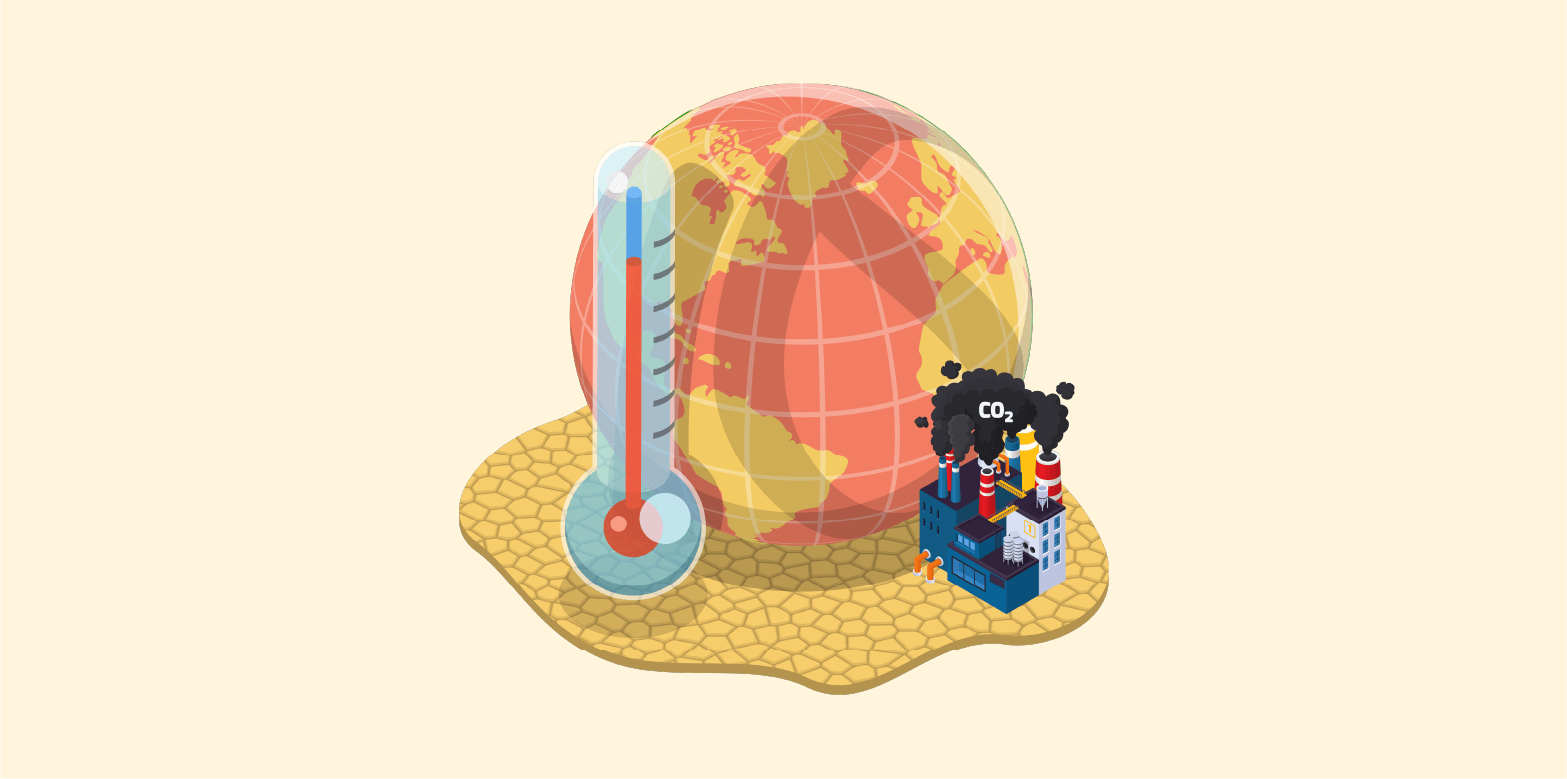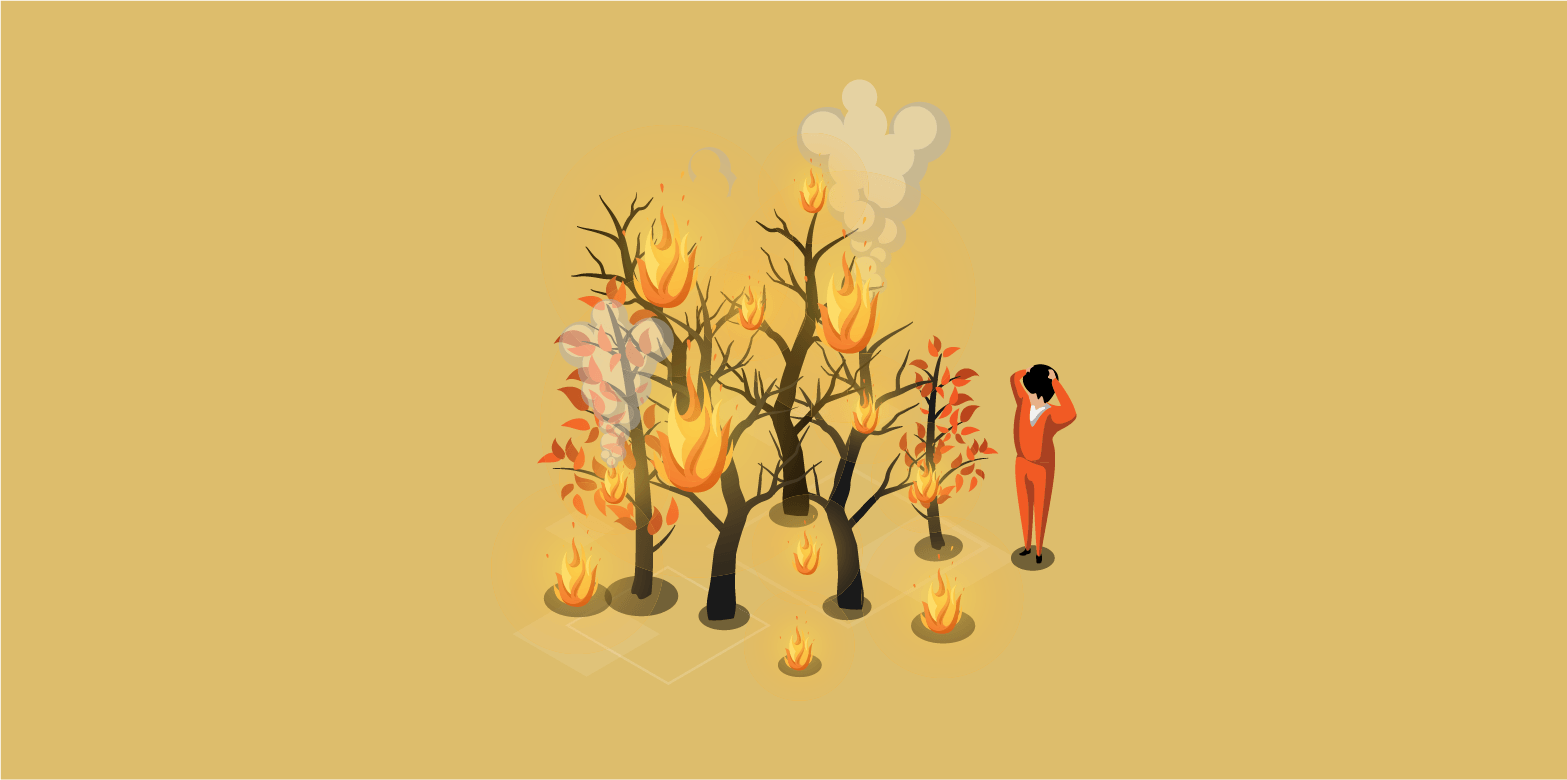The Heat is On: How Does Climate Change Affect Wildfires?
ALCHERA
May 16, 2023
May 16, 2023
Climate Change and Wildfires: Why Should We Care?
Table of Contents
How Climate Has Changed in the Past 100 Years around the Globe and in the USA
• Global climate change
• Climate change in the USA
Why Climate Change and Wildfires Are Related
• How does climate change affect wildfires?
How To Minimize the Effect of Climate on Wildfires
• Forest management for minimizing the effect of climate change on wildfires
• Fire-resistant infrastructure for mitigating the effect of climate change on wildfires prevention
• Greenhouse gas emission reduction for minimizing the effect of climate change on wildfires
• Latest technologies for minimizing the effect of climate change on wildfires
FireScout by ALCHERA: the Only 24/7 Wildfire Detection Solution
As climate change continues to take center stage in global discussions, it has become increasingly important to understand its impact on various aspects of our environment. Among these are wildfires, which have become more frequent and destructive in recent years. The intricate relationship between climate change and wildfires necessitates a closer examination of how the two are intertwined. In this post, we will explore the changes in climate over the past century, the role of climate in wildfire frequency, how climate specifically affects wildfires, and the innovative ways technology, such as AI-enhanced cameras, can help minimize losses caused by wildfires.

How Climate Has Changed in the Past 100 Years around the Globe and in the USA
Global climate change
Over the last century, our planet has experienced significant shifts in its climate patterns, with many of these changes becoming more pronounced in recent decades. The alterations in climate can be attributed to both natural processes and human activities, with the latter playing an increasingly dominant role in recent years.
We have a full post dedicated to wildfire classification, causes, and prevention techniques. If you are curious about how human activities contribute to wildfires, check it out!
Globally, average surface temperatures have risen by approximately 1.2°C (2.2°F) since the late 19th century. This increase in temperature has been primarily driven by human activities such as burning fossil fuels, deforestation, and other land-use changes. The warming trend has accelerated in recent decades, with 19 of the 20 warmest years on record occurring since 2001. The consequences of this global temperature increase have been far-reaching, manifesting in various ways, including rising sea levels, more frequent and severe heatwaves, changes in precipitation patterns, and an increase in the frequency and intensity of extreme weather events.
The global rise in temperatures has also led to a significant decline in Arctic sea ice. Satellite observations show that Arctic sea ice has decreased by approximately 40% since the late 1970s, with the rate of decline accelerating in recent years. The loss of Arctic sea ice has wide-ranging implications for global weather patterns, ecosystems, and climate feedback mechanisms.
Changes in precipitation patterns have also been observed over the past century. Some regions have experienced increased rainfall, while others have faced prolonged droughts. These shifts in precipitation can be attributed to a combination of factors, including rising temperatures, changing atmospheric circulation patterns, and human-induced changes to the land surface. The altered precipitation patterns have led to more frequent flooding in some areas and more severe droughts in others, resulting in significant challenges for agriculture, water resources, and ecosystems.
Ocean acidification is another consequence of climate change. As the concentration of carbon dioxide (CO2) in the atmosphere increases due to human activities, a portion of this CO2 dissolves in the ocean, leading to a decrease in the pH of seawater. This process, known as ocean acidification, has significant implications for marine ecosystems, particularly those dependent on calcium carbonate structures such as coral reefs.

Climate change in the USA
In the United States, the past 100 years have also seen considerable climate change. Average temperatures have increased by about 1.3°F to 1.9°F, with the most rapid warming occurring in the West, Southwest, and Northeast. This warming trend has had widespread effects on ecosystems, agriculture, and water resources across the country.
Precipitation patterns have shifted as well, with some regions experiencing increased rainfall and others facing more prolonged droughts. For instance, the Northeast and Midwest have seen a marked increase in heavy precipitation events, leading to more frequent flooding. In contrast, the Southwest has experienced an increase in the severity and duration of droughts, contributing to water scarcity and increased risk of wildfires.
Moreover, the frequency and intensity of extreme weather events, such as hurricanes, floods, and heatwaves, have increased across the country. The 2020 Atlantic hurricane season, for example, was the most active on record, with 30 named storms, 13 hurricanes, and 6 major hurricanes. The increase in such extreme events can be attributed, at least in part, to the changes in climate observed over the past century.
Sea-level rise is another significant concern for the United States, particularly for low-lying coastal areas. Over the past century, global sea levels have risen by about 8 inches, with some regions experiencing even higher rates of sea-level rise. This increase is primarily due to the melting of glaciers and ice sheets, as well as the thermal expansion of seawater as it warms. Sea-level rise poses significant threats
Do you know which 5 US states are most affected by wildfires? No? Check out this post: The 5 States in the US Most Affected by Wildfires: Causes and Prevention Efforts.
Why Climate Change and Wildfires Are Related

Climate change and wildfires are related due to the influence of climate variables on the conditions that contribute to the ignition, spread, and intensity of wildfires. Several key factors link climate change and wildfires: temperature, precipitation patterns, snowmelt, extreme weather events, and wind patterns. Let's explore the connection between each of these factors and wildfire frequency.
How does climate change affect wildfires?
Temperature rise and wildfires
Climate plays a pivotal role in determining the frequency and intensity of wildfires. As temperatures rise and precipitation patterns change, the environment becomes more conducive to the spread of fires. Higher temperatures increase evaporation rates, leading to drier conditions and lower soil moisture levels. Consequently, vegetation becomes more flammable, making it easier for wildfires to ignite and spread.
Precipitation patterns and wildfires
Changes in precipitation patterns also play a significant role in wildfire frequency. Prolonged periods of drought can cause vegetation to become dry and brittle, increasing its susceptibility to ignition. On the other hand, increased rainfall in some areas may lead to more abundant vegetation growth, which can also fuel wildfires when these areas eventually experience dry spells.
Snowmelt and wildfires
Furthermore, climate change has led to earlier snowmelt and longer fire seasons. As warmer temperatures cause snow to melt earlier in the year, the ground and vegetation dry out sooner, creating an environment ripe for wildfires. The extended fire seasons also provide more opportunities for fires to ignite and spread, leading to an increase in the frequency and intensity of wildfires.
Behavior of pests and pathogens and wildfires.
Climate change can indirectly impact wildfires by affecting the distribution and behavior of pests and pathogens that target forests. For instance, warmer temperatures can allow pests like bark beetles to thrive and expand their range, causing widespread tree mortality. The dead trees left behind provide more fuel for wildfires, increasing the likelihood of larger, more destructive fires.
How To Minimize the Effect of Climate on Wildfires
To minimize the effect of climate change on wildfires, it is essential both to address the root causes of climate change and to implement adaptive strategies to better manage and prevent wildfires. Here are some steps that can be taken:
Forest management for minimizing the effect of climate change on wildfires
Improving forest management is crucial for maintaining healthy, resilient forests that are less susceptible to catastrophic wildfires. By adopting sustainable forest management practices, we can significantly reduce the risk of large-scale wildfires and preserve our valuable ecosystems. Here are some key strategies that can be implemented to enhance forest health:
- Controlled burns: Also known as prescribed fires, controlled burns are carefully planned and managed fires that help reduce the buildup of dead vegetation and other flammable materials in forests. By eliminating excess fuel, controlled burns can lower the risk of severe wildfires and promote the regeneration of fire-adapted plant species.
- Maintaining biodiversity: Biodiverse forests are generally more resilient to disturbances, including wildfires. By preserving and promoting a diverse range of plant and animal species, we can create more stable ecosystems that are better equipped to recover from wildfires and resist pest outbreaks.
- Monitoring and early intervention: Regularly monitoring forest health and identifying areas with increased risk of wildfire is essential for effective forest management. Early intervention measures, such as removing dead or dying trees and addressing pest outbreaks, can help maintain overall forest health and minimize the risk of wildfires.
Fire-resistant infrastructure for mitigating the effect of climate change on wildfires
Strengthening fire-resistant infrastructure is an essential component of minimizing the impact of wildfires on property and human life. By utilizing fire-resistant building materials and incorporating fire-safe designs into infrastructure, communities can be better prepared for wildfires and reduce the associated damage and loss of life. Here are some key strategies for enhancing fire-resistant infrastructure:
- Fire-resistant building materials: The use of fire-resistant building materials, such as metal roofing, stucco or brick siding, and tempered glass windows, can significantly reduce the risk of property damage during a wildfire. These materials are designed to withstand high temperatures and prevent the spread of fire, providing a higher level of protection for structures in wildfire-prone areas.
- Defensible space: Creating a defensible space around structures involves clearing flammable vegetation and other combustible materials within a specific distance, typically 30 feet or more, depending on local regulations. This space can slow the spread of fire and provide a buffer that allows firefighters to more effectively defend properties against wildfires.
- Fire-resistant building design: Incorporating fire-safe design elements into buildings can further enhance their resilience to wildfires. This may include features such as ember-resistant vents, fire-resistant decking, and well-sealed eaves and roof joints that can prevent embers from entering and igniting a structure.
Greenhouse gas emission reduction for minimizing the effect of climate change on wildfires
Reducing greenhouse gas emissions is a critical step in addressing the primary cause of climate change. By focusing on greenhouse gas emissions, we can mitigate the impact of climate change and wildfires. Here are some essential strategies to consider:
- Transition to cleaner energy sources: Moving away from fossil fuels and embracing renewable energy sources, such as solar, wind, and hydropower, can significantly reduce greenhouse gas emissions. This shift also supports the development of a sustainable, low-carbon economy.
- Implement energy-efficient technologies: By adopting energy-efficient technologies in industries, transportation, and buildings, we can reduce energy consumption and associated emissions. Examples include LED lighting, energy-efficient appliances, and electric vehicles.
- Promote sustainable agriculture: Sustainable agricultural practices, such as precision farming, crop rotation, and reduced tillage, can help minimize greenhouse gas emissions from agriculture. Additionally, promoting plant-based diets and reducing food waste can further decrease emissions related to food production.
Latest technologies for minimizing the effect of climate change on wildfires
There are two core dimensions in the development and utilization of new technologies for preventing wildfires.
First, supporting research and innovation is essential for long-term resilience to the impacts of climate change and wildfires. By investing in research, we can gain a deeper understanding of the relationship between climate change and wildfires and develop new technologies and strategies to mitigate their consequences. This includes exploring fire-resistant materials, early detection systems, and sustainable forest management practices. Through continuous research and innovation, we can strengthen our ability to adapt to a changing climate and reduce the devastating effects of wildfires on communities and ecosystems.
It is also important to utilize new technologies in the right way. Enhancing early detection and monitoring systems is crucial for effectively responding to and containing wildfires. By implementing advanced technologies, we can detect wildfires at their earliest stages and enable rapid response measures. Here are some key technologies that can improve wildfire detection and monitoring:
- AI-enhanced cameras: Artificial intelligence (AI) can be integrated with cameras to analyze real-time images and detect the signs of a wildfire, such as smoke or a sudden increase in temperature. These cameras can quickly alert emergency responders, allowing them to take immediate action to contain a fire.
- Satellite imagery: Satellites can provide high-resolution images of large areas, enabling the monitoring of potential wildfire hotspots and the detection of fire outbreaks in real time. Satellite data can also help track the progression of wildfires and predict their future spread, aiding in response planning and resource allocation.
- Remote sensing: Remote sensing technologies, such as LiDAR (Light Detection and Ranging) and infrared sensors, can gather data on vegetation, moisture content, and temperature to identify areas at high risk for wildfires. These technologies can also help detect active fires and monitor their progression.
- Integrated monitoring systems: Combining multiple data sources, including AI-enhanced cameras, satellite imagery, and remote sensing, can create a comprehensive wildfire monitoring system. This integration enables a more accurate and timely detection of wildfires, as well as more effective response planning and resource allocation.

However, there is one common problem with new technologies - they tend to be more expensive and more complicated than traditional, widely used ones. These are two main reasons why people and governments may be hesitant to utilize new technologies, even though they are extremely accurate and effective.
If you are still unsure which wildfire technology to choose, we have a post wherein we compare traditional and AI-enhanced wildfire prevention and detection technologies.
Thus, new technologies should not only solve the wildfire detection problem, but also be affordable and easy to use.
This is where FireScout comes in.
FireScout by ALCHERA: the Only 24/7 Wildfire Detection Solution
FireScout, developed by ALCHERA, is a prime example of a state-of-the-art solution for wildfire prevention and detection. FireScout uses advanced machine learning algorithms to analyze live video feeds from cameras strategically placed throughout high-risk areas. By continuously monitoring these feeds, FireScout can identify unusual heat signatures and smoke patterns, providing real-time alerts to authorities when a potential wildfire is detected.
Moreover, FireScout's AI algorithms can also analyze historical data to predict areas at increased risk for wildfires, enabling targeted preventative measures such as controlled burns, vegetation management, and infrastructure maintenance. By harnessing the power of AI, FireScout significantly reduces the time between wildfire ignition and detection, allowing for faster and more effective response efforts that can save lives, property, and natural resources.
As climate change continues to shape our environment, the need for innovative solutions to address its consequences, such as wildfires, becomes increasingly vital. Understanding the relationship between climate change and wildfires is critical in informing policies, resource allocation, and the development of cutting-edge technologies to minimize the devastating impacts of these disasters.
The introduction of AI-enhanced cameras, such as FireScout by ALCHERA, offers a promising avenue for early detection and prevention of wildfires, ultimately saving lives and minimizing economic and environmental losses. By embracing these technologies and implementing proactive strategies, we can better adapt to the challenges posed by climate change and work towards a safer and more resilient future.
...
...


